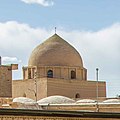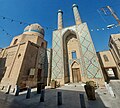This is a list of mausoleums in Iran, sorted by period established. A mausoleum is a building constructed as a monument enclosing a grave of a person or a group of people. [1] In Iran, a mausoleum can be a standalone building, or it can be attached to a mosque or even function as a mosque. [2] Sometimes such buildings can be known as an Imamzadeh .







































